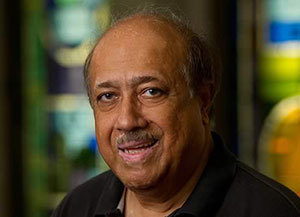 Ahsan Kareem
Ahsan Kareem
Ahsan Kareem, the Robert M. Moran Professor of Civil and Environmental Engineering and Earth Sciences at the University of Notre Dame, has been named an honorary member of the Japan Association for Wind Engineering (JAWE).
The largest individual country organization, there are only three international honorary members in the JAWE. Kareem is the first from the United States and one of only a few researchers whose work has transformed his field through a continued series of innovations. Over the years he has been acknowledged for his eminence in the field of wind engineering, structural engineering and engineering mechanics; and for profound contributions to the knowledge base with immediate applications, e.g., American Society of Civil Engineers Standard of Wind Loads and for development of Web-based analysis and tools for design practice.
Kareem, who serves as the director of Notre Dame’s NatHaz Modeling Laboratory, specializes in probabilistic structural dynamics, fluid-structure interactions, structural safety and the mitigation of natural hazards. To better understand and predict the impact of natural hazards on the constructed environment, he uses computer models and laboratory and full-scale experiments to study the dynamic effects of environmental loads under winds, waves and earthquakes on structures and to develop mitigation strategies to enhance the performance and safety of structures. He has served as a Notre Dame faculty member since 1990.
The research findings of Kareem and his team continue to have a major influence in the area of structural engineering, including monitoring of hurricane winds and their load effects; development of innovative structural systems for tall buildings and analysis procedures for offshore drilling and production platforms; monitoring performance of coastal construction, deepwater offshore structures, tall buildings, bridges and industrial structures; risk modeling; and development of cyber-based collaborations for research and education in wind effects. His work has also resulted in more than 185 journal publications and significant appointments, such as editor-in-chief of the international journal of Wind and Structures and associate editor of the Journal of Structural Engineering and Journal of Engineering Mechanics.
In addition to his research and classroom responsibilities, he is currently serving a two-year term as chair of the Technical Activities Division of the Structural Engineering Institute of the ASCE. This division administers the technical activities of the institute through a host of technical committees, e.g., dynamic effects, blast loads, fire, tall buildings, bridges and performance of structures. The division also oversees three journals of ASCE, including the journals of Structural Engineering and Bridge Engineering. Shaping the technical agenda of the institute, the technical division also contributes to the major annual Structures Congress. Kareem has previously served in a similar role for the Engineering Mechanics Division (now institute) of ASCE.
Among his most recent honors are selection as a distinguished member of the ASCE, election as a member of the U.S. National Academy of Engineering and a foreign fellow of the Indian National Academy of Engineering, receipt of the ASCE’s State-of-the-Art Award for scholarly contributions to full-scale monitoring of tall buildings, appointment as an honorary professor at Tongji University in Shanghai and selection as the inaugural recipient of the Alan G. Davenport Medal, presented by the International Association for Wind Engineering in recognition of his distinguished achievement in the dynamic wind effects on structures. He also received the Robert H. Scanlan Medal for outstanding original contributions to the study of wind-load effects on structural design and the Jack E. Cermak Medal in recognition of his contributions to the study of wind effects on structures. His receipt of the Davenport, Scanlan and Cermak medals is an unmatched recognition in this field.
Kareem graduated from the West Pakistan University of Engineering and Technology with distinction in 1968 and, through a joint program with the Massachusetts Institute of Technology, he earned his master’s degree in structural engineering from the University of Hawaii. He earned his doctorate in civil engineering, with a focus on structural and fluid dynamics, from Colorado State University.